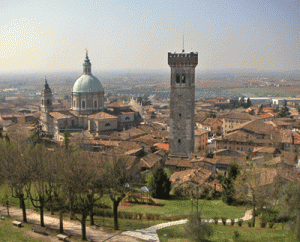
TERRITORY OF LONATO DEL GARDA
Hamlets: Barcuzzi, Bettola, Brodena, Campagna di Sotto, Castel Venzago, Centenaro, Cominello, Drugolo, Esenta, Fossa, Lido, Madonna della Scoperta, Malocco, Maguzzano, Salera, San Cipriano, San Polo, San Tomaso, Sedena.
Surrounding municipalities: Bedizzole, Calcinato, Calvagese della Riviera, Castiglione delle Stiviere (Mn), Cavriana (Mn), Desenzano del Garda, Padenghe sul Garda, Pozzolengo, Solferino (Mn)
HISTORY OF LONATO DEL GARDA
In the territories of Lonato is sure the human presence as early as the Upper Paleolithic, with exhibits on Mount Gabbione and Poleca and in Paleo-Mesolithic in Pozze, Fenile, Schena. During the Bronze Age settlements increase with the presence of dwelling villages in swampy areas between the morainic hills and the coast of lake, called “Lavagnone“, the people of this time and of this area were part of the so-called “Culture of Polada “(2000-1700 BC), named by locality Polada of Lonato, as in the second half of the nineteenth century they started various clean-up operation in the area that brought to light a considerable number of exhibits. The Iron Age, however, has not left many traces, if not two graves of Celtic times. More important was the Roman era documented by the presence of an important industrial kilns for firing briks, the “Fornaci romane” (Roman kilns) dated I-III century AD found on the road between Desenzano and Castiglione, while areas of housing development as agricultural villas have been found in places Pozze, Fenile, Schena. In 1814 on Monte Mario was found a mosaic that revealed the existence of a house, a sarcophagus and coins of the imperial period, hence the hypothesis that the current center is not the same as the old one they refer to the first historical documents , but that it was located further north, to the Church of San Zeno. The next Lombard domination, to the eighth century, has left its mark in the names of some places, see Centenaro, Gazzo and Venzago. The extension of the religious settlements gradually made life safer in the territory. To the tenth century the needs of people changed, the looting of the Hungarians and the development of trade forced the population to create a new housing development in a more comfortable and safe, so it was fortified Mount Cova and moved to its slopes the core of country, although the church was that of San Zeno. The situation did not change substantially until the fourteenth century, the town of Lonato with a larger fortress and several surrounding nuclei with small fortifications, and in 1337 it was handed over by the Scala to Visconti, but in 1339 Lodrisio Visconti, rebel of the family, sacked with ferocity Maguzzano, the old town and the parish church of St. Zeno. The fortress was rebuilt by Azzone Visconti and the new town was consolidated in the current position, but the wars between Visconti, Scala and other families to their allies continued for decades, and it was through the establishment of the Gonzaga family, allies of the Visconti, Lonato who lived some peace, although its history is a succession of steps of hand between the various families and Venice, where he remained from 1440 to 1797. The civil and military administration of Lonato is entrusted to a mayor and a superintendent, the first was sent to Italy and resided in the building citadel while to play the second role is left for several years a castle. Only after the plague of 1630 Lonato experiencing a period economically prosperous and wealthy families began to build houses within the walls for security and prestige, thus moving from a rural to an urban civilization. At the beginning of the eighteenth century a new period of struggle disturbs the territory, the war of the Spanish Succession, including the Imperial House of Savoy, the French and the Spanish, while the Serenissima remains neutral, while the country a new phase of economic development that it leads to the construction of new rich buildings, such as the Duomo. Towards the end of the century they begin fighting between imperial and French, with a succession of struggles, epidemics and steps armies arrive until 1859, with the Battle of Solferino and San Martino and the armistice that left the Veneto to Austria. During the end of the century and the beginning of the twentieth there was a period of serious economic situation and poverty, during which part of the population of Lonato emigrated to America.
LOCAL PRODUCTS OF LONATO DEL GARDA
